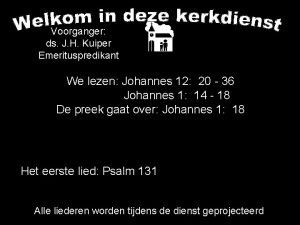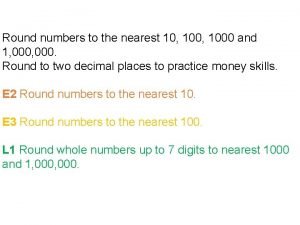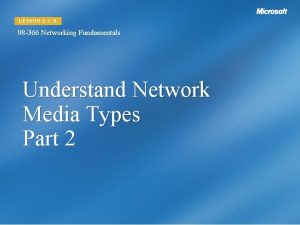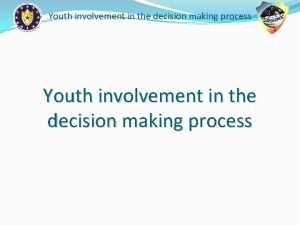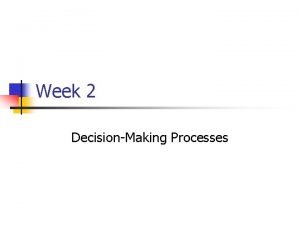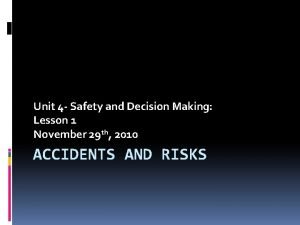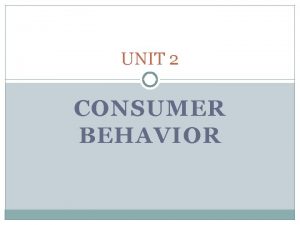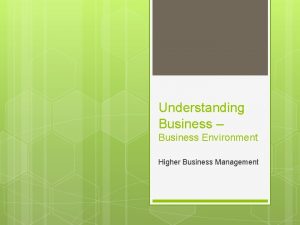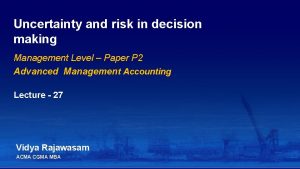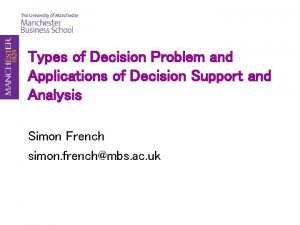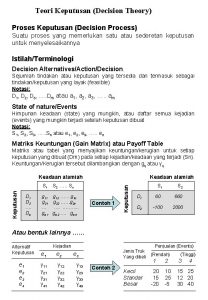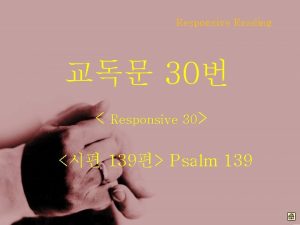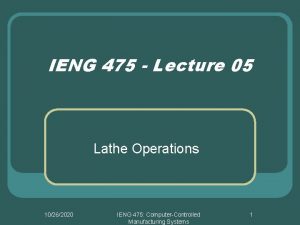IENG 366 Decision Making Reading pp 134 139



























- Slides: 27

IENG 366 Decision Making Reading: pp. 134 – 139.

DECISION MAKING Managerial decision making is the process of making a conscious choice between two or more rational alternatives

• Systems View • Include all of the significant, interrelated variables of the problem • Team Approach • Personnel with heterogeneous backgrounds / training work together • Emphasis is on the use of: • formal mathematical models • statistical methods • quantitative techniques Management Science Characteristics

Real World Model World • Formulate the Problem • Construct a Mathematical Model • Test the Model • Derive a Solution from the Model • Apply the Model’s Solution to the Real System Management Science Process

1. Define the problem 2. Collect data 3. Develop hypotheses 4. Test hypotheses 5. Analyze results 6. Draw conclusion Planning Process: Scientific Method

1. Define the problem 2. Collect and analyze the data 3. Search for alternatives 4. Evaluate alternatives 5. Select solution and evaluate the impact Engineering Problem Solving Approach

• Certainty • Risk • Uncertainty Categories of Decision Making Tools

Table 5 -1 Payoff Table • If the probability of any one outcome state is 1. 0 (certainty), then just pick the alternative with the best payoff. Decision Making Under Certainty

Linear Programming • One of best known tools of Management Science • Used to determine optimal allocation of an organization’s limited resources Decision Making Under Certainty

Preliminaries • State the Problem • Identify the Decision Variables • Formulate the Objective Function • Formulate the Constraints Linear Programming

Figure 5 -1 Linear program example: Iso-Profit Lines.

P = $10 x + $14 y (Machining Time) P = $560 P = $620 (Assembly Time) P = $0 P = $400 Figure 5 -2 Linear program example: Constraints and Solution.

• Expected Value • Decision Trees • Queuing • Simulation Decision Making Under Risk

Table 5 -3 Well Drilling Example—Decision Making Under Risk

Buying Fire Insurance: Payoff Table 5 -2 Decision Making Under Risk

Buying Fire Insurance: Decision Tree and Expected Value Figure 5 -3 Example of a decision tree.

Queueing Theory Applications Table 5 -4 Typical Waiting-Line Situations

Continuous Risk Model: Risk as a Variance Table 5 -5 Data for Risk as Variance Example

Figure 5 -4 Projects with the same expected value but different variances.

• Maxi-Max • • Maxi-Min • • • Maximize the minimum outcome (least bad) Hurwicz • Choose a position in-between optimism and pessimism • α = % optimistic outcome happens, 1 - α = % pessimistic outcome happens Equally Likely • • Maximize the maximum outcome (best case) α = 50% for two outcomes (etc. ) Mini-Max Regret • Minimize the maximum regret (regret = payoff left unclaimed) Decision Making Under Uncertainty

Table 5 -6 Decision Making Under Uncertainty Example

Table 5 -7 Well Drilling Example— Decision Making Under Uncertainty— Regret Analysis

• Six Thinking Hats • Rock, Paper, Scissors (Lizard, Spock) • Coin flipping, drawing straws, throwing dice Other Techniques

Table 5 -8 Effect of Management Level on Decisions

Investing in a New Facility Decision The applicable payoff table of profits (+ ) and losses (- ) is: How Would YOU Decide?

Investing in New Tooling Decision If your alternatives and their outcomes (in thousands of dollars) are as shown in the following table, what should be your decision? How Would YOU Decide?

Questions & Issues? IENG 366 Engineering Management
 5 letter words with ieng
5 letter words with ieng Objectives of decision making
Objectives of decision making Dividend decision in financial management
Dividend decision in financial management Opwekking 366
Opwekking 366 92 rounded to the nearest ten
92 rounded to the nearest ten Ps 366
Ps 366 Pobble 365 a dangerous pet
Pobble 365 a dangerous pet Each pair of wires is wrapped in metallic foil
Each pair of wires is wrapped in metallic foil 98 366
98 366 Na jednom kraju bakrene cijevi duljine 366 m
Na jednom kraju bakrene cijevi duljine 366 m Pre reading while reading and post reading activities
Pre reading while reading and post reading activities Decision tree and decision table examples
Decision tree and decision table examples Youth involvement
Youth involvement Essential steps for ethical problem-solving
Essential steps for ethical problem-solving Systematic decision making process
Systematic decision making process Paced decision making
Paced decision making Mamdm
Mamdm Using recursion in models and decision making sheet 3
Using recursion in models and decision making sheet 3 Paced decision making
Paced decision making Unit 4 lesson 1 decision making
Unit 4 lesson 1 decision making How to improve marketing performance
How to improve marketing performance Types of decision making
Types of decision making Corporate culture higher business
Corporate culture higher business Contribution payoff table
Contribution payoff table Types of decision making
Types of decision making Diagnostic role of marketing research
Diagnostic role of marketing research Police critical decision making model
Police critical decision making model Contoh soal decision making
Contoh soal decision making



